
The froghoppers, or the superfamily Cercopoidea, are a group of hemipteran insects in the suborder Auchenorrhyncha. Adults are capable of jumping many times their height and length, giving the group their common name, but they are best known for their plant-sucking nymphs which encase themselves in foam in springtime.

The Arrau turtle, also known as the South American river turtle, giant South American turtle, giant Amazon River turtle, Arrau sideneck turtle, Amazon River turtle or simply the Arrau, is the largest of the side-neck turtles (Pleurodira) and the largest freshwater turtle in Latin America. The species primarily feeds on plant material and typically nests in large groups on beaches. Due to hunting of adults, collecting of their eggs, pollution, habitat loss, and dams, the Arrau turtle is seriously threatened.

A leafhopper is the common name for any species from the family Cicadellidae. These minute insects, colloquially known as hoppers, are plant feeders that suck plant sap from grass, shrubs, or trees. Their hind legs are modified for jumping, and are covered with hairs that facilitate the spreading of a secretion over their bodies that acts as a water repellent and carrier of pheromones. They undergo a partial metamorphosis, and have various host associations, varying from very generalized to very specific. Some species have a cosmopolitan distribution, or occur throughout the temperate and tropical regions. Some are pests or vectors of plant viruses and phytoplasmas. The family is distributed all over the world, and constitutes the second-largest hemipteran family, with at least 20,000 described species.

Treehoppers and thorn bugs are members of the family Membracidae, a group of insects related to the cicadas and the leafhoppers. About 3,200 species of treehoppers in over 400 genera are known. They are found on all continents except Antarctica; only five species are known from Europe. Individual treehoppers usually live for only a few months.

The Auchenorrhyncha suborder of the Hemiptera contains most of the familiar members of what was called the "Homoptera" – groups such as cicadas, leafhoppers, treehoppers, planthoppers, and spittlebugs. The aphids and scale insects are the other well-known "Homoptera", and they are in the suborder Sternorrhyncha.

The buffalo treehopper is a species of treehopper belonging to the subfamily Membracinae. It is sometimes classified as Ceresa bisonia.
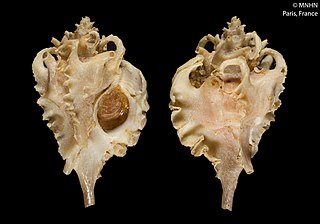
Typhina is a genus of sea snails, marine gastropod mollusks in the subfamily Typhinae of the family Muricidae, the murex snails or rock snails.
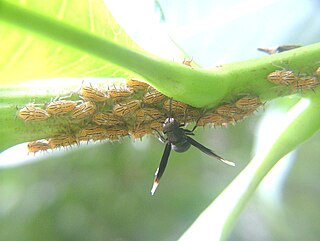
Parachartergus apicalis is a species of wasp in the Polistinae subfamily, found in the Neotropics. It was first described by Johan Christian Fabricius in 1804. In Honduras, they are known as alas blancas, which translates into English as "white wings".
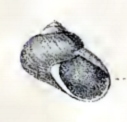
Margarella expansa is a species of sea snail, a marine gastropod mollusk in the family Calliostomatidae.
Puncturella expansa, common name the broad puncturella, is a species of sea snail, a marine gastropod mollusk in the family Fissurellidae, the keyhole limpets and slit limpets.

Enchenopa binotata is a complex of multiple species found mostly in Eastern North America, but have also been reported in Central America. They are commonly referred to as treehoppers and are sap-feeding insects. The species in the complex look similar to each other in morphology, but are identified as different species by the host plant they occupy.

Entylia carinata, commonly known as the keeled treehopper, is a species of treehopper in the family Membracidae. They can be found in Brazil, Panama, Mexico, the United States, and Canada. Keeled treehoppers are often attended by ants which feed on the honeydew they excrete. In return, the ants offer protection from predators. Keeled treehoppers typically feed on plants in the aster family and they are not known to transmit plant diseases and are not considered significant plant pests.

Microcentrus caryae, the hickory stegaspidine treehopper, is a species of treehopper in the family Membracidae.
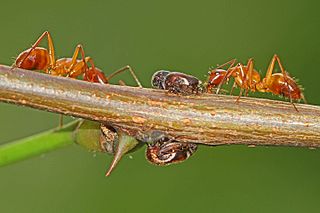
Vanduzea is a genus of treehoppers in the family Membracidae. There are about 12 described species in Vanduzea.
Dictya expansa is a species of marsh fly in the family Sciomyzidae.
Pholeomyia is a genus of freeloader flies in the family Milichiidae. There are more than 30 described species in Pholeomyia.

Antianthe is a genus of treehoppers in the family Membracidae. There are about seven described species in Antianthe.
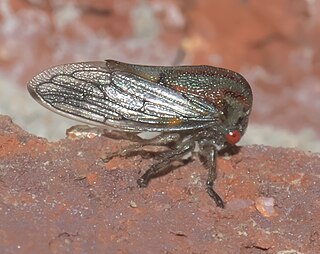
Platycotis is a genus of treehoppers in the family Membracidae. There are about 13 described species in Platycotis.

Platycotis vittata, the oak treehopper, is a species of treehopper in the family Membracidae, found in North America. The species is also called Platycotis vittatus.

Hebetica sylviae is a member of the treehopper family Membracidae. It is found in the eastern United States, first discovered in Murray, Kentucky, with a second sighting in Atlanta, Georgia.
















